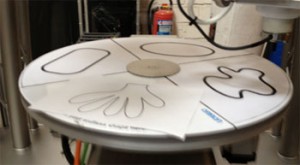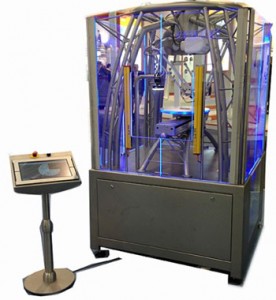Omron demos path tracing delta robot at PPMA
 A demonstration robot cell at the 2015 PPMA show highlighted innovative applications in pattern recognition and path tracing. Visitors to the show’s Robot Feature Area were able to draw their own freeform shapes, present them to the vision system within the cell, and then watch as the delta robot traced the shape. The system accurately followed the path even as the shape is rotated or moved back and forth on a linear slide to demonstrate on-the-fly conveyor synchronisation.
A demonstration robot cell at the 2015 PPMA show highlighted innovative applications in pattern recognition and path tracing. Visitors to the show’s Robot Feature Area were able to draw their own freeform shapes, present them to the vision system within the cell, and then watch as the delta robot traced the shape. The system accurately followed the path even as the shape is rotated or moved back and forth on a linear slide to demonstrate on-the-fly conveyor synchronisation.
The demo cell featured an Omron delta robot, controlled by a Sysmac NJ controller, and linked to Omron’s FH vision system, with a light curtain to ensure user safety. When a drawing of a shape is presented to the cell through the light curtain, the FH vision camera first scans it to create the data points. Image filtering for increased contrast and background suppression improves the scan for outline detection. From the outline, the vision system splits the path by buffers of 128 points each, and generates the output XY data of equally spaced points.
The whole process happens at high speed, with the vision algorithms executed over a multicore processor system to reduce inspection time. The algorithm skips the traditional pre-calculation that would conventionally be used in pattern recognition – a task that has high computational cost. This allows faster calculations to be performed and the cell to operate within a real time control systems context.
The XY data is sent to the NJ PLC, which connects these output data points using interpolation to create a smooth curve. The total length of the path is calculated from the number of points and distance between pairs of points, supplied by the FH vision system. With the total distance calculated and the curves smoothed, the trajectory data and velocity profile can be applied, with the velocity data used to calculate the distance from the initial position to the current position.
A key feature of the system is its ability to synchronise with the speed of a conveyor – simulated in the demo cell using the rotary turntable and linear slide. A third degree polynomial interpolation is recalculated at every CPU tick (1ms) and based on time instead of the maximum speeds and accelerations, which are checked constantly during the path execution.
 The demo highlights a host of applications for path following where it is either not possible or desirable to have the path generated within a CAD system. The ability to draw a closed shape freehand and have it accurately traced saves time and could have important applications in areas such as food production, packaging, healthcare and more, enabling new levels of customisation for short batch runs or even single products, with full flexibility for changes in the design.
The demo highlights a host of applications for path following where it is either not possible or desirable to have the path generated within a CAD system. The ability to draw a closed shape freehand and have it accurately traced saves time and could have important applications in areas such as food production, packaging, healthcare and more, enabling new levels of customisation for short batch runs or even single products, with full flexibility for changes in the design.
The demonstration addresses a number of key issues and trends across industries. The fast teaching time means minimal downtime on the production line, and eliminates the requirement for generating a CAD profile first, which can be a time consuming operation in itself. It also highlights how the use of integrated robotics and vision technology can enable more flexible production, and offers huge potential to improve efficiency, reduce costs and improve throughput.
Further, the robot cell highlights the ease of integration and programming of different technologies for machine builders. With Omron’s Sysmac platform, the controller, robot, vision system, safety technology, drives and servos are all connected over EtherCAT and programmed using a single unified software package, reducing programming, configuration and set-up times and offering the assurance that the final system will work as expected. Programming of the robot is particularly simple for such a complex application, using only one function block based on time for synchronising with the conveyor.
Visit the Omron website for more information
See all stories for Omron
Previous page PPMA Show 2015 report Next page















